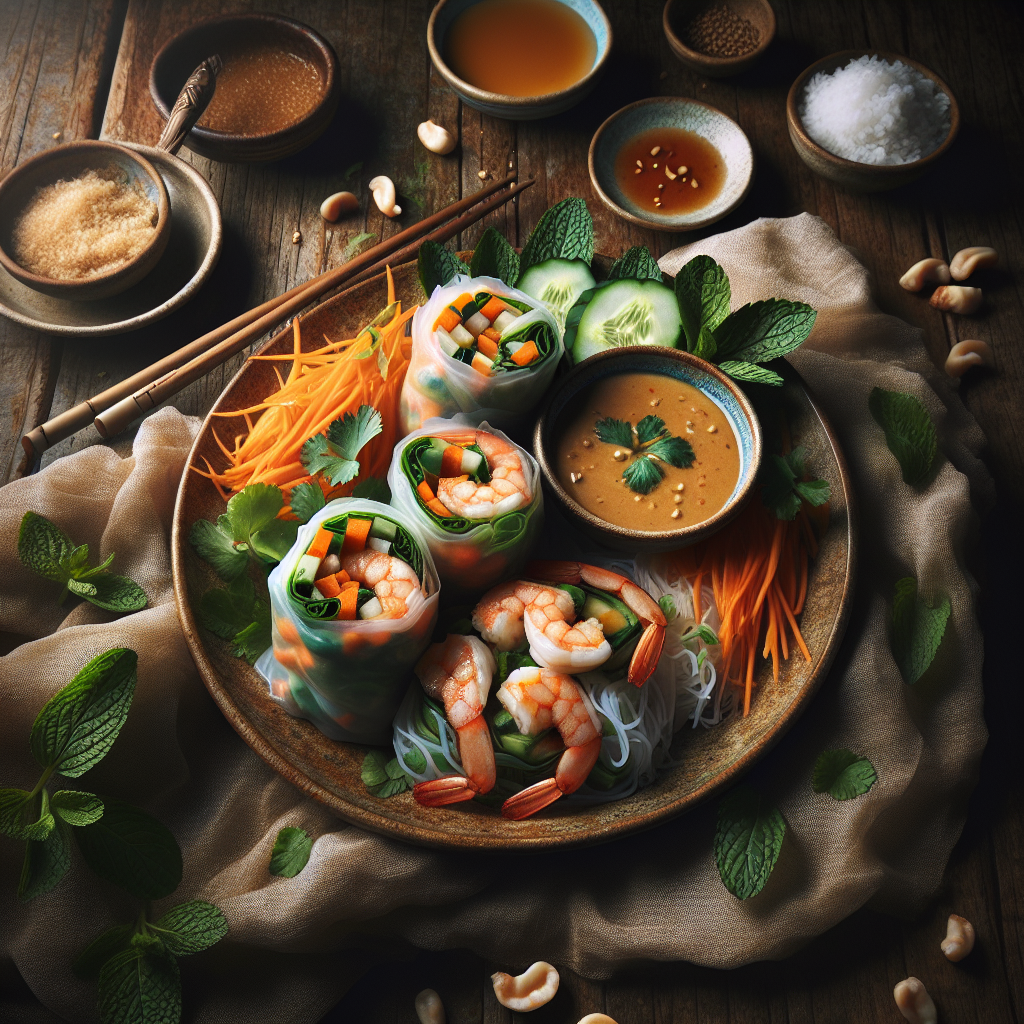
Master the art of making restaurant-quality Thai spring rolls at home! These fresh, vibrant rolls are packed with succulent shrimp, crisp vegetables, and aromatic herbs, all complemented by a creamy homemade peanut sauce that will transport your taste buds straight to Thailand.
Ingredients for Fresh Thai Shrimp Spring Rolls with Homemade Peanut Sauce
- 8 pieces Rice Paper Wrappers
- 3.5oz Rice Vermicelli Noodles
- 3.5oz Carrots, julienned
- 3.5oz Cucumber, julienned
- 0.7oz Fresh Mint Leaves
- 0.7oz Fresh Cilantro
- 7oz Cooked Shrimp, halved lengthwise
- 2oz Smooth Peanut Butter
- 1oz Soy Sauce
- 0.5oz Rice Vinegar
- 0.5oz Honey
- 2 cloves Garlic, minced
- 1 tbsp Fresh Ginger, grated
- 2oz Warm Water
Instructions for Fresh Thai Shrimp Spring Rolls with Homemade Peanut Sauce
- Cook 3.5oz rice vermicelli according to package instructions. Drain and set aside to cool.
- For the peanut sauce: In a bowl, whisk together 2oz peanut butter, 1oz soy sauce, 0.5oz rice vinegar, and 0.5oz honey
- Add 2 cloves minced garlic, 1 tbsp grated ginger, and 2oz warm water to the sauce. Whisk until smooth. Set aside.
- Fill a large bowl with warm water. Dip one rice paper wrapper in the water for about 5 seconds until it starts to soften.
- Lay the wrapper on a clean, damp kitchen towel. In the center, arrange about 0.9oz cooked shrimp, 0.4oz vermicelli noodles, 0.4oz carrots, and 0.4oz cucumber.
- Top with a few mint leaves and cilantro sprigs.
- Fold the bottom of the wrapper over the filling, then fold in the sides, and roll tightly like a burrito.
- Repeat with remaining wrappers and ingredients.
- Serve spring rolls with the peanut dipping sauce.
A Fresh Take on Thai Shrimp Spring Rolls: Where Tradition Meets Modern Flavors
As a chef who grew up straddling two culinary worlds, I've always been drawn to dishes that celebrate the perfect harmony of fresh ingredients and thoughtful preparation. Thai Shrimp Spring Rolls embody this philosophy beautifully, offering a light yet satisfying experience that's become increasingly popular in Western kitchens. These translucent parcels are a testament to the Thai culinary tradition of balancing textures and flavors – crisp vegetables, tender shrimp, chewy rice noodles, and aromatic herbs, all embraced by delicate rice paper wrappers.
What makes these spring rolls truly special is their versatility and healthfulness. With just 285 calories per serving, they're packed with 18 grams of protein and offer a beautiful array of nutrients from fresh vegetables and herbs. The accompanying homemade peanut sauce adds a rich, creamy element that transforms these rolls from simple to sublime, creating that perfect combination of fresh and indulgent that we all crave.
Master These Tips for Perfect Thai Shrimp Spring Rolls
After years of making these rolls both professionally and at home, I've gathered some crucial tips that will help you achieve restaurant-quality results:
-
Temperature matters: Use lukewarm water for dipping the rice paper – too hot and they'll become too soft, too cold and they won't be pliable enough.
-
Don't oversoak: Rice paper should only be dipped for about 5 seconds. It might feel slightly stiff when you remove it, but it will continue to soften as you work with it.
-
Prep ahead: Have all your ingredients cut and arranged before you start rolling. Think of it as setting up a sushi station – organization is key!
-
The double-towel technique: Work on a clean, damp kitchen towel, but have a second dry towel nearby to pat ingredients if they're too wet, especially the noodles and vegetables.
-
For the peanut sauce: If it's too thick, gradually add warm water until you reach your desired consistency. If it's too thin, add a little more peanut butter.
Serving Your Thai Spring Rolls with Style
Presentation is crucial for these beautiful rolls, and there are several ways to make them shine. I recommend arranging them on a platter lined with fresh lettuce leaves, adding visual appeal and preventing them from sticking. Slice them diagonally if serving as an appetizer, or leave them whole for a more substantial meal.
The peanut sauce can be served in individual ramekins or in a communal bowl with a spring roll dipper. I love to garnish the platter with additional fresh herbs, lime wedges, and crushed peanuts to add both visual appeal and extra texture options for guests.
For a complete meal, consider serving these spring rolls alongside:
- A light lemongrass soup
- Thai iced tea
- A spicy green papaya salad
- Fresh mango slices for dessert
From My Grandmother's Kitchen to Yours: A Spring Roll Story
The first time I attempted to make spring rolls, I was seven years old, standing on a stool in my grandmother's kitchen in San Francisco. She had moved from Thailand decades earlier but maintained her culinary traditions with unwavering dedication. I remember her gentle hands guiding mine as we dipped the rice paper, showing me exactly how long to hold it in the water – "Count to five, no more, no less," she'd say in her melodic accent.
My first attempts were hilariously misshapen – more like spring lumps than rolls – but she never criticized. Instead, she'd say, "Each roll tells a story of the hands that made it." Over the years, I've made thousands of spring rolls, and while mine are now consistently shaped and neatly packed, I sometimes intentionally make one slightly imperfect, just to remember those early lessons in her kitchen.
This recipe is a tribute to her teachings, though I've adapted it slightly for modern kitchens and appetites. The addition of a ginger-forward peanut sauce is my own twist – one she eventually admitted was "not bad for a new idea." Coming from my grandmother, that was high praise indeed.
Smart Substitutions for Thai Shrimp Spring Rolls
As someone who's made countless spring rolls both at home and in professional kitchens, I know that sometimes you need to work with what you have. Here are some tried-and-true substitutions that won't compromise the authentic taste of these Thai shrimp spring rolls:
For the Protein:
- Swap shrimp for 7 oz (200g) of poached chicken, tofu, or even crab meat
- For a vegetarian version, use pan-fried tofu or tempeh marinated in soy sauce
- Consider using surimi (imitation crab) if shellfish isn't available
For the Vegetables:
- Replace carrots with shredded daikon radish or bell peppers
- Swap cucumber for jicama or green papaya for extra crunch
- If you can't find fresh herbs, Thai basil can replace both mint and cilantro
For the Wrapper:
- While rice paper is ideal, lettuce leaves can work for a low-carb option
- If rice vermicelli is unavailable, try thin bean thread noodles
- Kelp noodles make an excellent low-carb alternative to rice noodles
For the Peanut Sauce:
- Almond or sunflower butter can replace peanut butter
- Coconut aminos make a great soy sauce alternative
- Apple cider vinegar works in place of rice vinegar
- Maple syrup or agave can substitute for honey
- Fresh ginger paste (store-bought) can replace grated ginger
Important Nutritional Information
Each serving of these Fresh Thai Shrimp Spring Rolls (2 rolls per serving) contains:
- Calories: 285
- Protein: 18g
- Carbohydrates: 35g
- Fat: 9g
- Sugar: 6g
These spring rolls are a nutritionist's dream, offering a well-balanced combination of lean protein from the shrimp, complex carbohydrates from the rice noodles and wrapper, and essential vitamins and minerals from the fresh vegetables and herbs. The peanut sauce adds healthy fats and protein, though it should be enjoyed in moderation due to its caloric density.
Some notable nutritional benefits:
- High in lean protein, supporting muscle maintenance
- Rich in fiber from vegetables, aiding digestion
- Contains omega-3 fatty acids from shrimp
- Excellent source of vitamins A and C from carrots and cucumber
- Provides essential minerals like zinc and iron
- Low in saturated fat
- Contains beneficial compounds from fresh herbs
Allergy Considerations and Modifications
When serving these Thai Shrimp Spring Rolls, be aware of these common allergens:
Major Allergens Present:
- Shellfish (shrimp)
- Peanuts (in the sauce)
- Soy (in the sauce)
For those with shellfish allergies:
- Use cooked chicken or tofu instead of shrimp
- Ensure all utensils and surfaces are thoroughly cleaned to avoid cross-contamination
For peanut allergies:
- Replace peanut sauce with alternative dipping sauces like:
- Sweet chili sauce
- Almond butter-based sauce (if tree nuts are safe)
- Sunflower seed butter sauce
- Vietnamese nuoc cham (fish sauce-based dipping sauce)
For soy allergies:
- Use coconut aminos instead of soy sauce
- Choose fish sauce as an alternative (check labels for soy content)
Storage Tips for Maximum Freshness
To keep your Thai Shrimp Spring Rolls at their best:
Assembled Rolls:
- Store up to 24 hours in the refrigerator
- Wrap each roll individually in damp paper towels
- Place in an airtight container
- Line the container with lettuce leaves to maintain moisture
Peanut Sauce:
- Keeps for up to 1 week in the refrigerator
- Store in an airtight container
- May need to be thinned with warm water when reused
Prep Components Separately:
- Cooked shrimp: 2-3 days refrigerated
- Prepared vegetables: 2-3 days in sealed containers
- Cooked noodles: 3-4 days when stored properly
- Fresh herbs: 5-7 days when wrapped in slightly damp paper towels
Frequently Asked Questions About Thai Spring Rolls
Q: Why do my rice paper wrappers keep tearing? A: Don't soak them too long - 5 seconds in warm water is usually enough. They'll continue to soften as you work with them.
Q: Can I make these ahead for a party? A: Yes, but no more than 4-6 hours ahead. Store them wrapped individually in damp paper towels in an airtight container.
Q: Why are my rolls getting soggy? A: Make sure to drain the noodles and vegetables well, and don't oversoak the rice paper. Pat herbs dry before using.
Q: Can I freeze these spring rolls? A: Fresh spring rolls don't freeze well. For best results, serve them fresh or within 24 hours.
Q: How do I keep the rolls from sticking together? A: Don't let them touch when storing, and wrap each one individually in damp paper towels.
Wrapping Up These Delightful Thai Shrimp Spring Rolls
As a chef who's passionate about Asian cuisine, I can confidently say that these Fresh Thai Shrimp Spring Rolls represent the perfect blend of tradition and accessibility. They're not just a dish; they're a celebration of fresh ingredients, vibrant flavors, and the joy of hands-on cooking.
Whether you're serving them as an appetizer at your next dinner party or enjoying them as a light lunch, these spring rolls offer a healthful, satisfying option that's sure to impress. The combination of succulent shrimp, crisp vegetables, and that irresistible peanut sauce creates a harmony of flavors that's both authentic and adaptable to your preferences.
Remember, the key to perfect spring rolls lies in fresh ingredients and practice with the rolling technique. Don't be discouraged if your first few attempts aren't picture-perfect – even the most experienced chefs started somewhere. The beauty of these rolls is that they'll be delicious regardless of their appearance.
